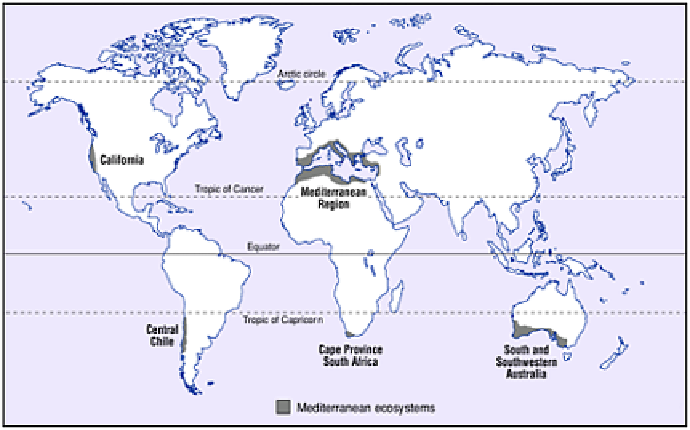Environmental Engineering Reference
In-Depth Information
CLIMATE, PRESENT AND PAST
The typical climate which is found on the western coasts of continents in subtropical
latitudes is the Mediterranean type with its hot, dry summers and mild, wet winters. This
Figure 26.1
The world distribution of Mediterranean
environments.
seasonal contrast in temperature and precipitation is driven by seasonal changes in the
position of subtropical high-pressure cells, and associated westerly jet streams in the
upper troposphere. In the Mediterranean region proper the summer months are dominated
by the eastward extension of the Azores high-pressure cell. The anticyclonic nature of
this large-scale circulation gives rise to atmospheric subsidence and hence stability. Low-
pressure weather systems can occur but are usually very local and weak. The summer
heat is reinforced by regional winds from continental tropical (cT) source regions which
can cause a sudden decline in relative humidity to 20 per cent, and temperatures rise to
above 40° C. These winds are known by a variety of local names -
scirocco
(Algeria and
the Levant),
ghibli
(Libya),
khamsin
(Egypt) and
lebeche
(Spain). Other hot local winds
can be very humid where there is a long fetch over the Mediterranean Sea (e.g. the
Levante
in southern Spain).
The high-pressure cell collapses quite suddenly in late October and early November.
The subtropical high and its associated westerly jet stream move south to a position over
the Sahara, allowing Mediterranean depressions to form and bring winter precipitation.
These depressions are formed by incursions of air masses from many directions - mT air
from the Atlantic, mP from the North Atlantic and north-west Europe, mA and cA from
the Arctic and northern Russia, cP from Asia and cT from the Sahara. The formation of
depressions (cyclogenesis) is stimulated by the relatively high sea surface temperatures,

